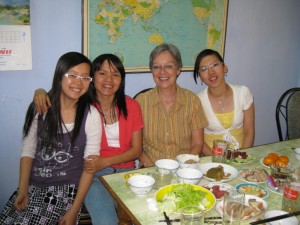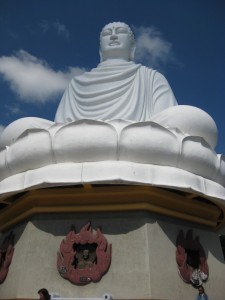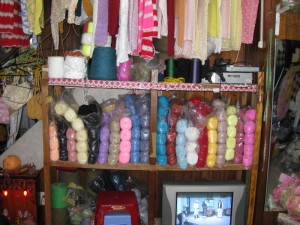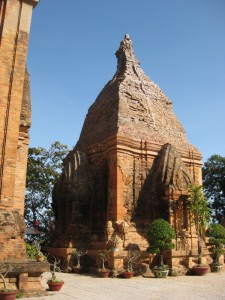More Vietnamese hospitality
01/29/2009

So much has happened since I last wrote that it will be difficult to summarize it all. On the second day of Tet, Ms. K., seated to my right, invited me to a lunch of special Tet holiday foods at her parents' home. While there I met several people, including these two young women who are attending school in Australia. If you like pork and sausage, you would have enjoyed this meal, which featured several kinds. I really enjoyed talking with Ms. K's parents, who treated me with great warmth, and meeting some of their friends.

On Wednesday, Mr. T. (who took me to the countryside on Sunday) invited me to visit with some more of his relatives and I had a lovely walk (of about 6 miles) along the beachfront with Mr. K., who is from Bangladesh. As we walked, he told me of his interest in learning more about American history. "Christopher Columbus discovered America," he said. "Then what?" After I chuckled a bit, I started to answer some of his many far-ranging questions. I was impressed by the knowledge he possesses simply from reading everything he can find. Downtown we noticed a crowd and joined it in time to see some colorful and very acrobatic dancers. There are two men in each costume, and sometimes these animals became very tall, and at other times they rolled on the ground.
Each day is proving to be an unanticipated delight. On Wednesday evening I received a phone call and thought the caller was saying that she would take me for a haircut Thursday morning at 8. Much to my surprise, it was Ms. H's sister (not the woman I expected) who showed up at the dorm. It took me a little while before I figured out that I was going to spend the day sightseeing.

Our first stop was the National Oceanographic Museum, located in the port district at the far south end of Nha Trang. There we saw many tanks of colorful marine life--including clown and cuttle fish, seahorses, eels, sharks, seals, and 60,000 jars of pickled specimens. I really enjoyed learning about the tropical fish of this region from a local. She made a point to tell me which ones could be eaten and which ones would kill you if consumed. In contrast with American museums, I was surprised that you could touch some of the preserved specimens and even lift a starfish out of its pond.
Next, we drove north to the Long Son Pagoda. When I got off the motorbike, little children immediately surrounded me and thrust joss sticks in my face, which they wanted me to buy. We walked up a few steps to the pagoda, and at our first stop saw a monk striking a gong. The main sanctuary is an impressive array of traditional motifs, and people with lit joss sticks raised their hands in prayer before a statue of the Buddha.

Near the top of a 150-step ascent we began to see beggars (some of whom look quite destitute) and vendors. Then, before us, was this huge white Buddha seated on a lotus blossom. Around the base of the statue are relief busts of the Buddhist monks who died by self-immolation in 1963. Inside the Buddha was an altar where people were praying before another statue of the Buddha. On the way up to the seated Buddha, we stopped before a statue of a reclining Buddha, also is an impressive piece of sculpture.
By now it was nearly eleven, so we went in search of a restaurant, only to find that many are still closed because of Tet. We found a nice open-air place on the beachfront and lingered there talking for a couple of hours. I was fascinated by the women who make their living by selling various things on the beach--sunglasses, bottles of water, fruit, and even seafood. There were ice cream vendors on bicycles from which you heard strains of music, like "Happy Birthday to You." Of course, there were other sights that tug at the heartstrings, like the man with no arms and only stumps for legs hobbling down the sidewalk begging for coins. An enterprising older lady in a conical hat carried a charcoal cooker, a steamer, a bucket of lobsters, and several other kinds of seafood. She even had a pan for washing dishes after her customers ate. Another woman came by carrying two large baskets on a pole. In one she carried bowls, spoons, and sugar, and in the other she carried tofu in a broth. My host ordered two bowls for us--it was like a dessert, slightly sweet-tasting.

The day was far from over! Over lunch I mentioned how much I love to knit and I asked my host if she knew of any stores that sold yarn. She remembered one in the city market and took me there next. In the store I saw many knitted garments hanging from rods suspended from the ceiling, and bags of yarn on shelves below. I bought two balls of what appears to be sock-weight yarn for 30,000 dong (less than $2) and took the woman's business card. I wonder if I can find the store again??? I hope so!
Our last stop was at the Po Nagar Cham Towers, where many tourist buses had parked. The site has been used for worship since the second century A.D., and the towers we saw today were built between the 7th and 12th centuries. Many Cham and Vietnamese Buddhists come here to pray, especially during Tet. Inside the North Tower, which was built in 817 A.D., I saw a black stone figure of the goddess Uma seated on some kind of animal. It was very crowded and warm in there, with some people praying, others taking photographs, others lighting joss sticks. It is not for the claustrophobic, at least today.

Only four of the original towers remain. The one pictured here shelters a linga (I didn't know what it was either--look it up!), which has a religious significance. Behind the towers we saw some Cham women selling beautiful woven goods and young women doing traditional dances. Sounds of traditional music also wafted through the air.
By this point in the day I was warm, a little tired, and ready to return to my dorm room. No sooner than I had changed clothes and settled before my laptop with a cool glass of juice was there a knock at the door. It was Mr. K., wondering if I would like to take another walk downtown. I decided to teach him a piece of American slang--"I think I'll take a raincheck."
